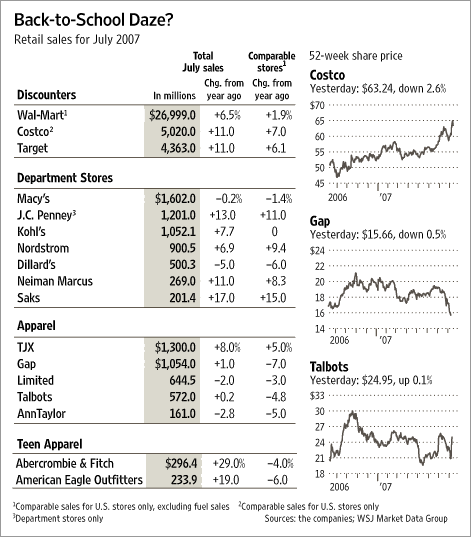Collectively, retailers posted a 2.9% increase in July same-store sales, or sales at stores open at least a year, according to an index of 48 major chains compiled by Retail Metrics Inc. More than half missed forecasts, and the result fell well short of the 3.9% increase logged in the year-earlier month, said Ken Perkins, president of the Swampscott, Mass., research firm. Year to date, same-store sales are up 2.8%, a sharp slowdown from the average gain of 3.7% seen in 2006.
OK -- let's not let the prism of a really shaky credit market cloud our vision.
2.9% growth isn't bad. It indicates consumers are still spending. However, the slowdown in same-store sales growth indicates consumers are slowing their purchases. This is consistent with the slowdown we are seeing in personal consumption expenditures in the BEA's personal income reports over the last few months.
The fact that economists missed the slowdown in their projections indicates there is probably still a bullish bias to economic models that needs to be ratcheted down right now.
However, not all the news was bad:
Wal-Mart, Bentonville, Ark., reported a 1.9% gain in same-store sales, at the high end of the 1% to 2% growth forecast it gave last month. But while sales were strong in food and electronics, they were driven by stepped-up promotions, with discounts on more than 16,000 products, said Eduardo Castro-Wright, president and chief executive of the company's U.S. stores.
...
Costco Wholesale Corp., which tends to attract well-heeled bargain hunters, posted a better-than-expected 7% increase, as shoppers flocked to its warehouse clubs for big-screen TVs, fine wines and stainless-steel appliances. Target Corp., whose shoppers are more affluent than Wal-Mart's, scooped up the "cheap chic" discounter's summer fashions, driving a 6.1% gain in same-store sales.
Here's the chart from the article. It looks like what is happening is consumers are concentrating all of their purchases in a few, bigger discounters rather than spreading out purchases over a variety of stores.

The point here is consumers are still spending; they're just not spending as much and they are becoming more discriminating about what they are going to buy.
PCE's increased 1.5% in the latest GDP report. This isn't great and is certainly a slowdown from the previous pace, but it's not horrible either.
Something to definitely keep your eye on is retail sales over the next 3-5 months. By then, we'll know how the credit market problems are really playing out with consumers.